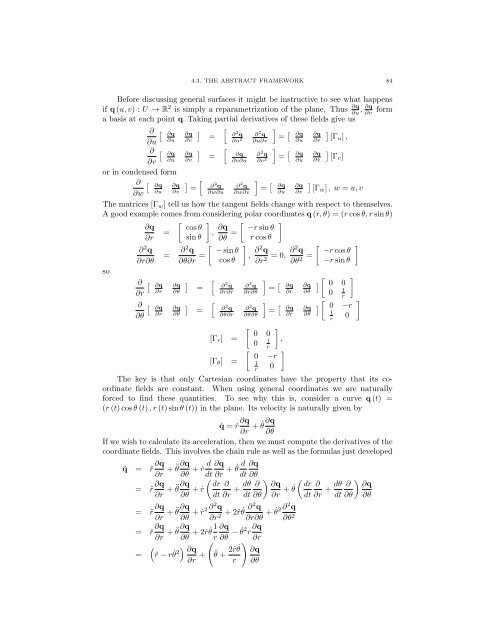Lecture Notes for 120 - UCLA Department of Mathematics
Lecture Notes for 120 - UCLA Department of Mathematics
Lecture Notes for 120 - UCLA Department of Mathematics
Create successful ePaper yourself
Turn your PDF publications into a flip-book with our unique Google optimized e-Paper software.
4.3. THE ABSTRACT FRAMEWORK 84<br />
Be<strong>for</strong>e discussing general surfaces it might be instructive to see what happens<br />
if q (u, v) :U ! R 2 is simply a reparametrization <strong>of</strong> the plane. Thus @q<br />
@u , @q<br />
@v<br />
<strong>for</strong>m<br />
abasisateachpointq. Taking partial derivatives <strong>of</strong> these fields give us<br />
@ ⇥ @q<br />
⇤ h<br />
i<br />
@q<br />
=<br />
@ 2 q @ 2 q<br />
= ⇥ ⇤<br />
@q @q<br />
@u<br />
@u @v<br />
@u 2 @u@v @u @v [ u] ,<br />
@ ⇥ @q<br />
⇤ h<br />
i<br />
@q<br />
=<br />
@q @ 2 q<br />
= ⇥ ⇤<br />
@q @q<br />
@v<br />
@u @v<br />
@v@u @v 2<br />
@u @v [ v]<br />
or in condensed <strong>for</strong>m<br />
@ ⇥ @q<br />
⇤ h<br />
i<br />
@q<br />
@w<br />
@u @v =<br />
@ 2 q @ 2 q<br />
= ⇥ ⇤<br />
@q @q<br />
@w@u @w@v @u @v [ w] ,w= u, v<br />
The matrices [ w] tell us how the tangent fields change with respect to themselves.<br />
Agoodexamplecomesfromconsideringpolarcoordinatesq (r, ✓) =(r cos ✓, r sin ✓)<br />
apple<br />
@q cos ✓<br />
=<br />
, @q apple<br />
@r sin ✓ @✓ = r sin ✓<br />
r cos ✓<br />
@ 2 apple<br />
apple<br />
q<br />
= @2 q<br />
@r@✓ @✓@r = sin ✓<br />
, @2 q<br />
cos ✓ @r 2 =0, @2 q<br />
@✓ 2 = r cos ✓<br />
r sin ✓<br />
so<br />
@ ⇥ @q<br />
⇤ h<br />
i<br />
@q<br />
=<br />
@ 2 q @ 2 q<br />
= ⇥ ⇤ apple @q @q 0 0<br />
@r<br />
@r @✓<br />
@r@r @r@✓<br />
@r @✓<br />
1<br />
0<br />
r<br />
@ ⇥ @q<br />
⇤ h<br />
i<br />
@q<br />
=<br />
@ 2 q @ 2 q<br />
= ⇥ ⇤ apple @q @q 0 r<br />
@✓<br />
@r @✓<br />
@✓@r @✓@✓<br />
@r @✓ 1<br />
r<br />
0<br />
apple 0 0<br />
[ r] =<br />
1 ,<br />
0<br />
r<br />
apple 0 r<br />
[ ✓] =<br />
1<br />
r<br />
0<br />
The key is that only Cartesian coordinates have the property that its coordinate<br />
fields are constant. When using general coordinates we are naturally<br />
<strong>for</strong>ced to find these quantities. To see why this is, consider a curve q (t) =<br />
(r (t) cos ✓ (t) ,r(t)sin✓ (t)) in the plane. Its velocity is naturally given by<br />
˙q =ṙ @q @q<br />
+ ˙✓<br />
@r @✓<br />
If we wish to calculate its acceleration, then we must compute the derivatives <strong>of</strong> the<br />
coordinate fields. This involves the chain rule as well as the <strong>for</strong>mulas just developed<br />
¨q = ¨r @q @q<br />
+ ¨✓<br />
@r @✓ +ṙ d @q<br />
dt<br />
= ¨r @q<br />
✓<br />
@q dr<br />
+ ¨✓<br />
@r @✓ +ṙ dt<br />
= ¨r @q @q<br />
+ ¨✓<br />
@r<br />
= ¨r @q<br />
=<br />
⇣<br />
¨r<br />
@r + ˙✓ d @q<br />
dt @✓<br />
@<br />
@r + d✓ @<br />
dt @✓<br />
◆ ✓ @q<br />
@r + ˙✓ dr<br />
dt<br />
@✓ +ṙ2 @2 q<br />
@r 2 +2ṙ ˙✓ @2 q<br />
@r@✓ + ˙✓ 2 @2 q<br />
@✓ 2<br />
@q<br />
+ ¨✓<br />
@r @✓ +2ṙ ˙✓ 1 @q<br />
˙✓ 2 r @q<br />
r @✓<br />
!<br />
@r<br />
r ˙✓ 2⌘ @q<br />
@r + ¨✓ 2ṙ ˙✓ @q<br />
+<br />
r @✓<br />
@<br />
@r + d✓<br />
dt<br />
◆<br />
@ @q<br />
@✓ @✓
















